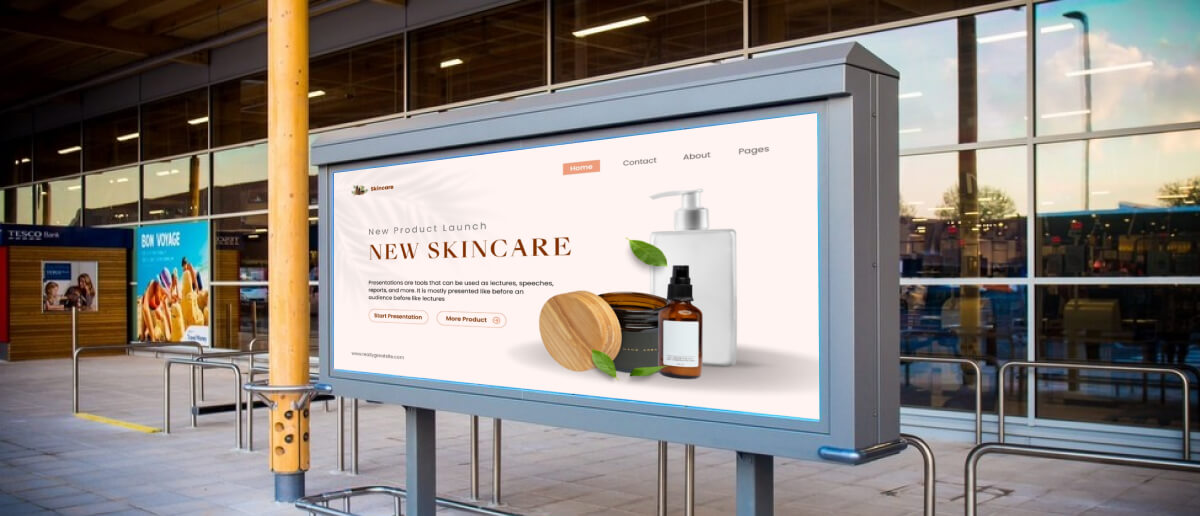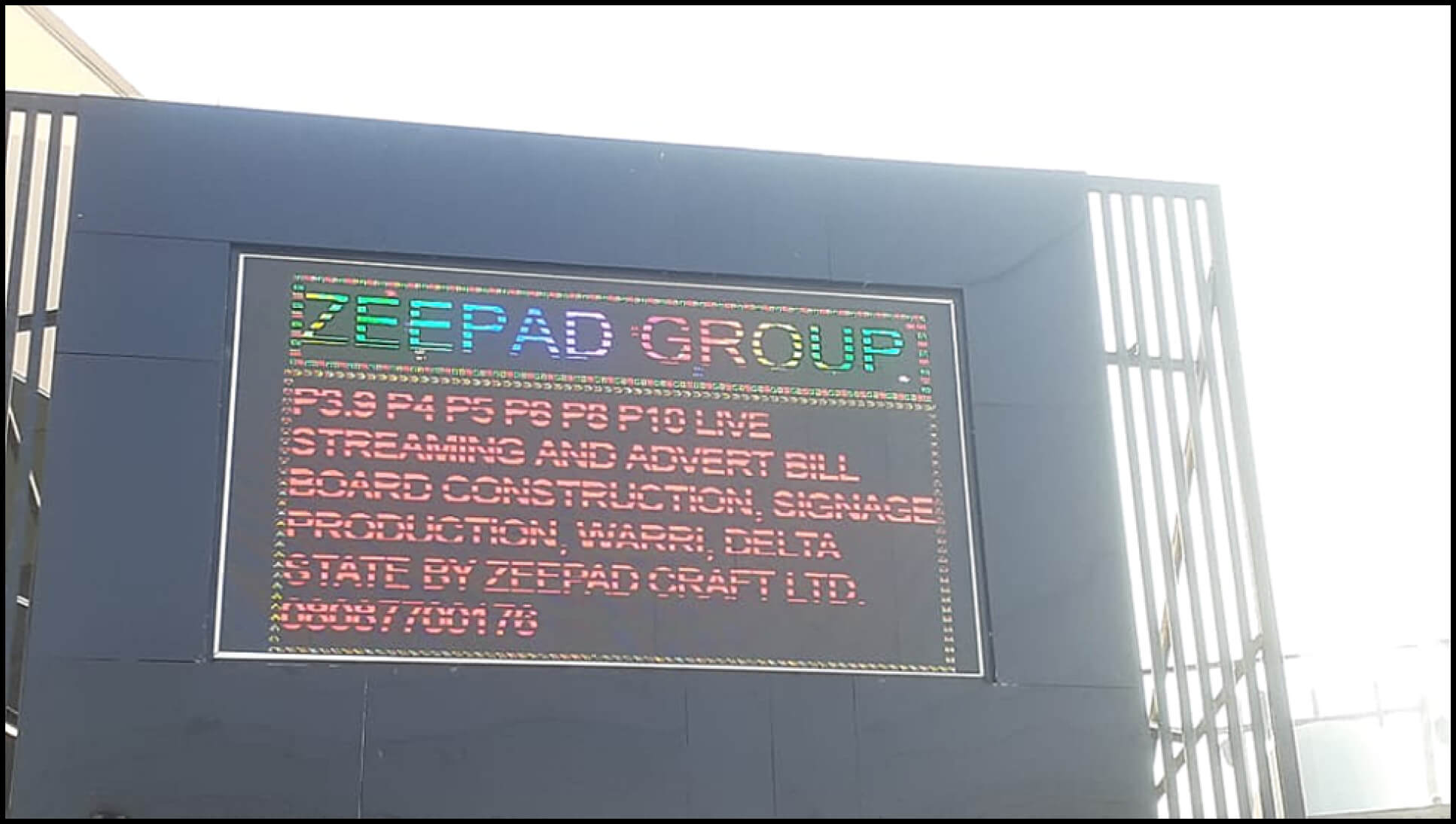
May 19 2023
5 min read


Apr
A usual crazy Monday. Vehicles are zipping past a 20X20 feet unipole holding outdoor digital signage. Pedestrians and commuters are rushing by. A few of them glance at the flashy advertisement. A few others are stuck in traffic. The rest are impatiently waiting at a nearby signal, trying to cross the road.
Right there is your window of opportunity.
You have spent months designing uber-cool digital outdoor signage. Now it stands tall amid a busy street. The rushing commuters barely have a few seconds to spare. Those few seconds will decide the fate of your advertisement.
Despite the chaos, your signage stands out if you avoid making the following mistakes:
Wrong choice of location
Extremely high mounting
Faulty viewing angle
Poor screen resolution and brightness
Incorrect screen size
Multiple moving parts
Static digital content
Content overload
Failure to customize
Poor planning and scheduling
Not considering the customer journey
Not gauging performance
Weak content strategy
You’re no stranger to the attention span crisis plaguing today’s digital world. Your digital signage is no exception. Done right, it will grab eyeballs in the busiest of streets. The hack is simple: make it easy for your viewers.
Simple design, less text, and catchy visuals.
That’s all it takes. Today’s blog will help you navigate the challenges brands face with outdoor digital signage. Let’s begin.
It’s a fast-paced world. And the location is everything. Months of effort could go down the drain if you position your outdoor digital signage in the wrong place. A wrong location equates to zero attention.
Your signage grabs minimal attention when you place them in the following:
Low-traffic and footfall areas
Wrong viewing angles
Too close to your target audience (visuals get pixelated)
Places with visual obstacles
Low maintenance
Poor choice of software
Best approach:
Your team needs to conduct site surveys to assess the best positioning of your outdoor signage.
Map out the nearest and farthest distance people can view your content from. Assess the percentage of people likely to cross that region and the percentage that won’t.
Ensure your signage boards are installed at a certain height or on mountings so people can see them from afar.
Be wary of visual barriers. Your signs are not meant to be fancy backdrops for lamp posts.
Mount your signage in a way to avoid obstructed views for a passerby. Take stock of other variables, too— for example, massive vehicles parked before your advertisement. Or seasonal plants growing in front of your signs and obstructing the view.
Check with local municipalities or authorities to ensure no major construction is happening there.
Install “No Parking” signs close to your display screens to avoid visual obstacles.
As a rule of thumb, your signage displays should be located close to entry and exit areas of nearby buildings and areas with high vehicle traffic and footfall.
The best approach is to situate them at eye level on famous streets.
Imagine crouching down or crushing your neck just to see a display board. If you hate it, so will every passerby.
Mounting your outdoor signage displays too high will make it difficult for people to view the content comfortably. They might simply cast a cursory glance and walk away.
Worse, they might ignore it.
You need your display content to register. And make the needful impact.
It’s interesting how Nike slays it with interactive digital signages at appropriate heights and positions.
Best approach:
Mount your screen at an optimal height to avoid clutter and make it less of a target for vandals. If your digital signage has interactive media or touchscreens, you must pay extra attention to the placement. Remember, your content has to cater for all demographics, including differently-abled people. The display should be easily reachable to those with wheelchairs and mobility aids.
Comfort is the key.
Mounting your digital outdoor signage at an incorrect angle is a lethal mistake. When you use signage for outdoor display, the reflective angle of the sun, screen size, and the viewing comfort of your audience are the key factors.
A faulty viewing angle often means:
Your display screen is too small or too big for the mounting
Incorrect mounting
Low-resolution display
The screen tilts beyond the line of sight
Screen specifications have not been adequately checked
Manufacturing defects
Best approach:
The following measures can prevent you from these rookie mistakes and improve the comfort level of your customers:
For better viewing angles, replace LED displays with LCD monitors. The pixels on LCD monitors are evenly lit with anti-glare features and offer better viewing angles.
Make sure your vendor provides accurate specifications of viewing angles.
Here’s your chance to be inclusive as a brand. Your viewers have different heights, so you must be wary of that. Select an optimal angle that would make it easy for all customers to view.
Note: The upper limit of the horizontal viewing angle is 178 degrees. The angle of touchscreen outdoor digital signage is between 30-55 degrees.
The ideal vertical viewing angle lies anywhere between your eye level and 30 degrees below the line of sight.
A killer logo and appealing graphics are not enough as long as they’re in your system. Scale and check for pixels when they are projected on a larger screen.
Low-resolution graphics will appear blurry when magnified.

Speaking of resolutions, your screen brightness matters just as much. Poor screen brightness is as bad as dazzling digital displays.
Outdoor digital signage with low illumination will make it difficult for readers to decipher your content.
Again, extremely bright screens are not readable in proper daylight, especially on bright sunny days.
If your outdoor signages are facing direct sunlight, using the right brightness and resolution is critical. Poor readability will reduce the potential reach and negatively impact your digital campaigns.
Best approach:
There’s one clear ground rule: For your outdoor display to be visible, the screen’s brightness should be more than the surroundings.
Here’s a quick guide:
Install automatic brightness and resolution controls. Your screen will automatically adjust the resolution and brightness at different daylight hours.
Use LED lights to make your sign visible even at night. These are energy- and cost-efficient.
Maintain these standard pixel dimensions for screens of different sizes:
960 pixels x 560 pixels = quarter high definition (HD)
1280 x 720 = standard HD / HD ready
1920 x 1080 = full HD
3840 x 2160 = Ultra HD
Not all digital screens are the same. While you save big bucks buying consumer-grade screens, your screen size and quality pay the price. Medium-quality consumer screens are effective only for a few hours.
That is not to say bigger screen size will serve better. Of course, they will provide a larger surface area for displaying your content. But what if your content is less? Staring at a massive screen displaying barely a few words is unappealing.
Equally unattractive are small screens with excess content.
Best approach:
Understand the purpose and location of your digital outdoor display and deploy screens accordingly. Here’s what helps:
Use small to medium-sized screens for smaller viewing distances and locations. For example, small outdoor kiosks usually display minimal content and need small screens.
Invest in commercial-grade monitors for large screens suitable for larger spaces and viewing distances (e.g., outside shopping malls, cinema halls, etc.)
How often do you run into damaged outdoor signage? Impossible to keep a count, I know. Broken or malfunctioning sign boards have become that common. Either their screens are blank, or their touchscreens don’t work.
Either they are weather-beaten. Or sun-damaged.
Neglect and low maintenance are tell-tale signs that a brand does not care about its image. Or about its customers.
Best approach:
These simple measures can help save your digital signage displays in outdoor environments:
Use UV-resistant waterproof display screens
Regular cleaning and inspection for damage
Software updates and periodic upkeeps
Install health- and performance-monitoring software
An essential aspect while setting up your outdoor displays is the choice of software. There’s no point in deploying digital signage if the software fails to deliver the expected results. Again, not regularly updating and optimizing your CMS is a fatal mistake businesses make.
Let’s see how you can make things right.
Best approach:
Use simple and user-friendly CMS for the best experience
Leverage the best software features to automate and create videos, animations, etc.
Make sure you are using files compatible with your software.
Pickcel's digital signage software offers the latest features, such as advanced scheduling, an app store, reports & analytics, mobile controls, etc. Click here to explore the complete list of our software features.
Streamline and simplify. That’s the mantra for a successful outdoor digital signage strategy. Traditional installations have a lot of components, such as control cables, display signal cables, network cables, and more— while these work fine for indoor signage, they’re a liability for outdoor displays.
More components equate to more points of failure.
It’s an outdoor environment. At any point, something might just break loose. This will cause disruptions.
Best approach:
Use new-age digital signage technology like Solid State Smart Signage Displays . These come with fewer components.
System-on-Chip (SoC) displays have embedded media players and require just one cable for power.
“Let’s convert this print into a digital version.”
It mostly happens when timelines are tight—the fastest way to kill your audience’s interest.
Blindly converting prints to digital boards with zero consideration for fonts, scaling, pixels, and the overall appeal no longer flies. People quickly lose interest in boring, static content. Nobody enjoys viewing the same content over and over again.
Best approach:
Stop treating your outdoor signage as a static hoarding. Switch things up with the following strategies:
Use videos, audio, animations, charts, live TV, social media features, and more
Keep updating your content
Even if you use static texts and images, ensure they have a creative appeal (e.g., bright colors, bigger fonts, etc.)
Avoid using more than two types of fonts in a single design
Viewers are 64-84% more likely to buy a product after watching a video.
If you use audio for outdoor signages, ensure the sound is evident when positioned in a particular location. Noisy environments can be challenging. Remember to use subtitles for a better user experience.
This is as bad as static content. People zipping by in their vehicles have a few seconds to grasp your content. Making it text-heavy or overcrowding the screen with irrelevant images will only repel them.
The last thing you want is for your content to get dismissed because of visual clutter.
Best approach:
Less is more. Outdoor digital signages appeal when you work things around:
Use larger screens or multiple small screens to display long messages
Trim chunks of text and use minimalistic visuals
Preview designs multiple times and adjusts your visuals accordingly. Check for visual hierarchy. There will always be texts and images you want to emphasize.
While viewing the template on your monitor, step back at least 5 feet away. This would help you simulate how your audience will view the display in real-time.
Maintain this standard visual hierarchy to attract your audience:
Headlines > Graphics > Bright Colours > High Contrast Items
Would you sell woollen socks in summer? Exactly! Your digital signage strategy revolves mainly around this question:
“How relevant is your content?”
This is the era of personalization. Your audience would spend minimal time on your digital displays. You must cater to their specific interest in those few seconds to avoid losing out on business.
Generic one-size-fits-all content does not work anymore.
Best approach:
It’s raining. A man is passing by a gas station and suddenly spots an outdoor ad displaying different kinds of umbrellas. Given people are often unprepared for sudden weather changes, imagine the opportunities your advertisement could tap into: simply by personalizing content based on location, time of the day, weather, and more.
The tailored experience served via digital signage may not match the extreme customization people get online. However, crafting campaigns around specific interest areas improves the customer journey and experience.
Attention is the currency. If you fail to plan your content, you’re losing out on your audience’s interest and attention. Despite tons of money invested in brilliant designs, viewers will only care about your displays if you show the same content throughout the year.
For videos and animations, stop playing the same content on a loop. Regular viewers passing by the exact location may eventually find your content monotonous, leading to stagnant sales.
For example, if your display resides on a shop window, you only need 1-2 minutes to loop the same content. If your signage is mounted on the road surface and is meant only for commuters, 30 seconds of viewing window is enough.
Here comes the worst of all. Be wary of expiring offers. Nothing damages your brand reputation more than not delivering what you promise.
Best approach:
Even your best content requires updating and rotation. These tips might come in handy:
Create a content calendar for regular scheduling
Use digital signage software to update content
Churn out fresh content, products, services, and promotions
Always keep your audience in mind when creating a digital signage content planner. For example, you may run more family-centric offers during holiday seasons or target different demographics during various times of the day or week.
Catering to different demographics can be challenging. But done right, they’ll skyrocket your business.
A common mistake businesses make with outdoor signage is: displaying unbranded content. This often makes your content irrelevant despite brilliant visuals.
Your customers fail to map the content with your brand.
Yet another customer pain point is an unclear Call to Action (CTAs). Promoting your offers is not enough; your business won’t achieve the desired results if you leave your potential buyers wondering what to do next.
That said, simply having a CTA is also not enough. Not using emphatic words, wrong positioning, or adding CTAs without testing is as bad as not having them.
Best approach:
Mapping your customer journey to your products is crucial. And your signages positioned outdoors play a key role. Incorporate these tried and true techniques to aid your customer journey:
Use the combination of the proper context and captivating audio-visuals to educate your customer on the overall vision of your product.
Make your CTAs catchy, crisp, and straightforward. E.g., asking your customer to contact a helpline, scan a QR code, or visit a website to learn more.
Personalize your CTAs and test them in terms of words, formats, length, and positioning.
Personalized CTAs convert 42% more viewers into customers than generic CTAs.
Metrics are everything. Having the best digital signage campaign strategy and not monitoring the performance becomes a single point of failure for businesses. You need to measure how your outdoor signage performs to ensure you can learn what works and what doesn’t.
With measurable Key Performance Indicators (KPIs), it is possible to gain insights into the success or failure of your business.
Best approach:
Plan your goals and have specific metrics to measure them
Think about how your KPIs can impact your business. E.g., number of app downloads, email clicks, QR code scans, etc.
Despite investing in the best outdoor displays and software, your digital campaign is not working. You wonder why.
A poor content strategy is ruining it for you.
Businesses often spend less time on the objectives of a campaign. Hence they achieve minimal optimization with their digital signage displays. For example, they might end up targeting the wrong audience.
Attention to detail is a business imperative. Many companies miss out on small pieces while developing a content strategy. It could be as simple as how long your content is displayed. Prolonged update of content makes people lose patience. Again, viewers may miss out on important details if your content scrolls too fast.
Legibility of your messages is necessary to convert interested viewers into customers.
Best approach: The easiest way to build a solid content strategy is to place yourself in the customer’s shoes. Your end goal should be one: to improve the user experience. Here’s how:
Keep your messages short and relevant
At every stage, understand how your content ties back to the overall strategy
Set achievable goals
Segregate your content according to your target audience
Success with outdoor digital signage is simple: the sign is on, viewers can easily see them, and the content displayed gives them reasons to stay glued. At Pickcel, we understand the struggles you face with your digital signage solutions and help you minimize them. Join our 5500+ clients today and make your outdoor signage stand out.
Schedule a demo today.
Take complete control of what you show on your digital signage & how you show it.
Start Free Trial Schedule My Demo
May 19 2023
5 min read

May 16 2023
8 min read

May 12 2023
9 min read

Apr 27 2023
5 min read